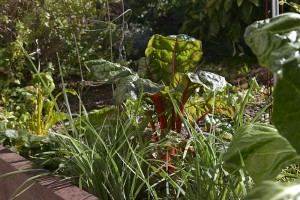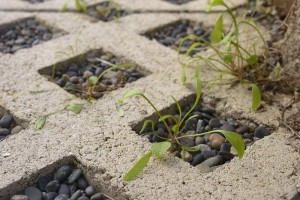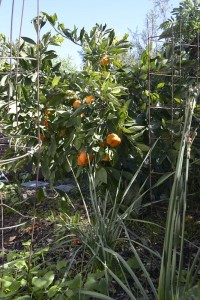What kind of vegetable gardener are you? Do you spend winter charting out rows and developing timetables for when things needs to go into the ground? Or does chance play a big part in what’s in your veggie garden?
Here’s a photo of one corner of my small veggie garden, proof that I’m definitely of the second school. I do a little tiny bit of planning. And I drool a little over veggie catalogs just like most of us do. But the garden that develops has a lot to do with what the garden wants to be this year, as much as what I want it to be.
I like chard. Chard likes me. For me it’s easy from seed. And if I buy a sixpack of something and let half of it go to seed, there’s usually enough chard plants coming back from seed for two or three years. In my near-coastal San Diego garden chard produces almost year-round, so it’s one of the backbones of the veggie garden. Russian red kale can do the same for me, though looking around the garden it’s time to get another generation going… Soil nematodes will eventually find both of these plants, so I like to give the plants a break and rotate what I’m growing.
Another staple that returns reliably is miner’s lettuce, Claytonia perfoliata. Once the weather cools and the rains start up it comes back all over the garden. You can find this fairly common California native state-wide when you’re out on the trail, and you’ll also find occasionally find it on the menus of adventurous restaurants.

The crisp-to-slightly succulent foliage has a mild flavor, something like spinach, but what makes it really cool are the rounded leaves that grow all around the stem (perfoliate leaves) when the plant begins to bloom mid-spring. Be sure not to pull out the youngest plants, which have long, strappy leaves. And don’t lose patience when you only get heart-shaped leaves for a while. (Call them “lover’s lettuce” and use them for a Valentine’s Day salad!) The anticipated round leaves will come, along with starry little white flowers on a short stem in the center of the round leaf. Very cool, and definitely worth the wait.

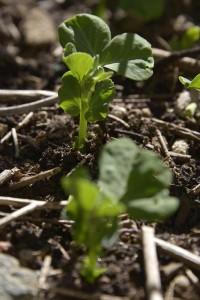
A little planning went into some of the other things in the garden. Pod peas are great this time of year, so I planned ahead to get some seeds into the ground in late October. Super Sugar Snap did well for me last season so I planted more of that variety. Unfortunately the raccoons dug up and dined on most of the seedlings, so I’ll be running a comparison with another pea variety, Oregon Sugar Pod II–racoons willing.
And what else? There’s some leftover dinosaur kale from two seasons ago, still alive, worth a salad every few months. And leeks. I’ve never had much luck with them, probably something to do with not watering them enough and not mounding soil around the developing stems. But the raccoons don’t seem to like them so far.
And strawberries, used in the garden more for groundcover and attractive green foliage than for berries. When they bear, it’s a great snack for the gardener pulling weeds. The berries almost never make it into the house.
And in the middle of all this randomness is a young tangerine tree, covered with delicious orange ornaments right now. Part of my veggie garden slacker-ness I blame on the tree. The plant is developing its root structure in the same place I have many of the veggies. The frequent cultivating and digging that goes with a traditional veggies garden would hurt the tangerine’s roots. So…more reason to only occasionally disturb the soil to plant things or pull them out. As the tree matures it’ll create more shade, as well as having a larger root system. By then it’ll be time to find a new spot for the veggies.
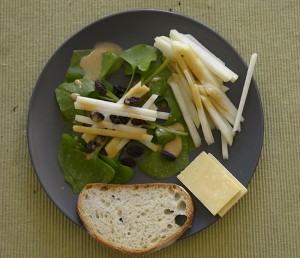 Until then, there’ll be a nice supply of ingredients for nice lunches like this one, with miner’s lettuce from the garden and crunchy kohlrabi from the store.
Until then, there’ll be a nice supply of ingredients for nice lunches like this one, with miner’s lettuce from the garden and crunchy kohlrabi from the store.
 And no, I do not live inside Sunset Magazine. The rest of the table looks something like this, complete with reading glasses for the morning paper and fluorescent pink string to amuse the cat…
And no, I do not live inside Sunset Magazine. The rest of the table looks something like this, complete with reading glasses for the morning paper and fluorescent pink string to amuse the cat…

